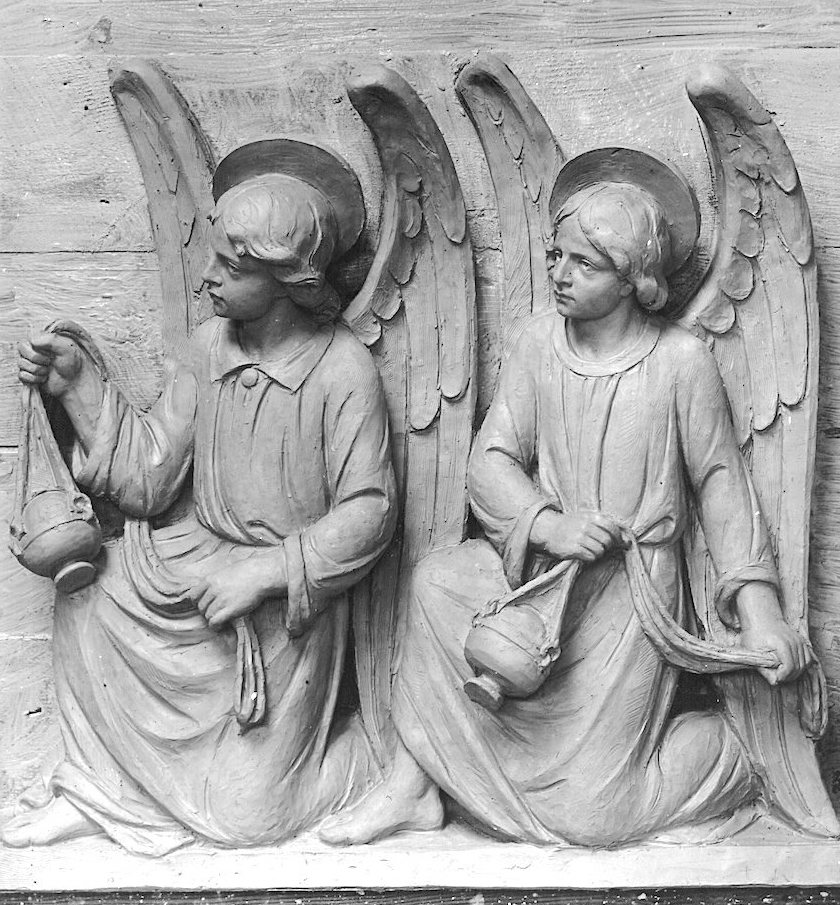Colour photographs by the author. Historic (black-and-white) photographs all by courtesy of W. Clarke, Llandaff. Formatting by Jacqueline Banerjee. You may use the images without prior permission for any scholarly or educational purpose as long as you (1) credit the photographer or W. Clarke, Llandaff, and (2) link your document to this URL in a web document or to the Victorian Web in a print document. [Click on all the images to enlarge them.]


Recent photographs. Left: View of St Ishan's church. Right: The church interior.
St Isan, Llanishen village, now part of Cardiff, is believed to date to the fifteenth century. A north isle was added by Prichard and Seddon in 1854, which was mostly replaced by a new nave and chancel with a north isle and chapel by H. D. Blessley between 1907 and 1908.


Left: Llanishen c. 1902 prior to Blessley's work. Right: Llanishen proposed reredos.
In 1904 Halliday designed a reredos for the Lady chapel, which was made by W. Clarke of Llandaff at a cost of £270. The wings and area beneath the altar comprise plain polished Penarth alabaster tiles, some of which are showing signs of damage due to damp. In the wings the tiled area is broken by a narrow band of carved Penarth alabaster and finished with an ornately carved cornice. Above the altar the main work is brought forward with three ornate tabernacles separated by four green Connemara marble columns and topped with alabaster pinnacles. In the centre, carved in high relief in Caen stone, is the seated figure of Christ, flanked either side by two angels bearing incense, which sit on a shelf. Beneath the angels are carved the words "HOLY", whilst beneath Christ the shelf is brough forward in an arc carved with leaves. At the base of the reredos is a band carved with leaves and ears of wheat.


Left: The reredos in situ. Right: A closer view of the carved figures/
Contemporary photographs in W. Clarke's archive indicate that the figures were first modelled in clay before being carved in stone, whilst the Day Book records show that the clay modelling and carving of the figures was undertaken by G. Profeti, who was also responsible for carving the foliage.



The reredos figures (photographs all slightly cropped and lightened). Left to right: (a) Censing angels on the left-hand side, in situ, with mosaic-work visible behind them. (b) Clay model of the central figure, Christ. (c) Clay models of the censing angels on the right-hand side.
To date, attempts to trace Profeti's origins have proved fruitless. The canopies were modelled in wood by Harry Gregory, son of the artist Charles Gregory (1810 – 1896) who lived his entire life on the Isle of Wight where he painted mostly nautical scenes. William Clarke's eldest son, William Jenkins Clarke (WJC) was also involved in this job, presumably as a stone carver. Other men known to have been stone and wood carvers who worked on this project included Henry Durnell, and Thomas Spragg.
Link to Related Material
Bibliography
Clarke, W. Llanishen Reredos Day Book 9: 117-8.
"Ecclesiastical News." Weekly Mail. 19 March 1904. 12.
Newman, John, with contributions from Stephen Hughes and Anthony Ward. The Buildings of Wales: Glamorgan (Mid-Glamorgan, South Glamorgan and West Glamorgan). London: Penguin/University of Wales Press, 1995.
"Reredos Dedicated at Llanishen." Evening Express. 23 December 1904. 3.
Statham, Michael. Penarth Alabaster. Welsh Stone Forum, 2017.
Created 29 July 2023